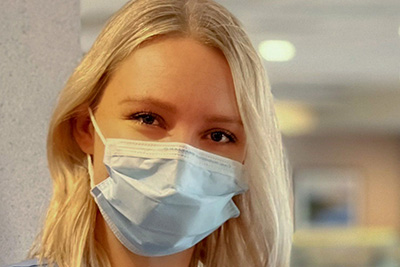Outdated or Unsupported Browser Detected
DWD's website uses the latest technology. This makes our site faster and easier to use across all devices. Unfortunatley, your browser is out of date and is not supported. An update is not required, but it is strongly recommended to improve your browsing experience. To update Internet Explorer to Microsoft Edge visit their website.

Tony Evers, Governor
Amy Pechacek, Secretary-designee
Department of Workforce Development
Secretary's Office
201 E. Washington Avenue
P.O. Box 7946
Madison, WI 53707-7946
Telephone: (608) 266-3131
Fax: (608) 266-1784
Email: sec@dwd.wisconsin.gov
FOR IMMEDIATE RELEASE
Oct. 12, 2022
CONTACT: DWD Communications
CommunicationsOffice@dwd.wisconsin.gov
Gov. Evers' Workforce Innovation Grant to Train Nursing Instructors and Nurses
GREEN BAY – As a nurse, Nichole Lauf's experience and empathy have guided countless patients through their most vulnerable moments.
As a co-clinical nursing instructor for Aurora BayCare Medical Center, she is motivated by the opportunity to teach technical skills and help cultivate a strong sense of compassion in the next generation of nurses. A new Workforce Innovation Grant awarded by the Wisconsin Department of Workforce Development and Wisconsin Economic Development Corp. (WEDC) to partners including UW-Green Bay, Aurora BayCare Medical Center, and HSHS St. Vincent will expand the pool of nursing instructors able to teach both "hard" and "soft" skills.
"When I heard about the grant it was really exciting or me," Lauf said. "Lots of people know that there's a nursing shortage, but they don't really know that there's an instructor shortage too. Now it feels like we're actively addressing the issue. For me, the reward is being able to share my knowledge and experience while also instilling the values of respect and compassion."

The project is part of an unprecedented investment in workforce development by Gov. Tony Evers. The $128 million Workforce Innovation Grant program builds on Wisconsin's record economic performance, with strategies to deliver more highly skilled workers in key industries, remove workforce barriers, and make the most of the state's homegrown talent with regional solutions. Among the targeted industries is the healthcare sector.
"A strong healthcare system is the foundation of our communities' well-being and it's also the foundation of a healthy economy," said DWD Secretary-designee Amy Pechacek. "Through Gov. Tony Evers' historic investment in the Workforce Innovation Grant program, this project will make a real difference in bringing more nurses into teaching and clinical roles."
Addressing Wisconsin’s nursing shortage requires the state, higher education and health care providers to look for new ways to create training opportunities and space in the state’s nursing degree programs, said Missy Hughes, WEDC secretary and CEO.
“Wisconsin is fortunate that so many young people already know that nursing is an important, demanding but fulfilling and family-supporting career choice,” Hughes said. “Now we must increase our training capacity to give these future nurses the skills they will need. Part of what is so exciting about this project is the potential for it to be replicated across the state and increase the number of nurses trained in Wisconsin each year.”
Aurora BayCare Medical Center President Thomas Miller praised the partnership for addressing an underlying challenge in healthcare.
"We hope our unique collaboration with academic nursing programs will help to provide the additional clinical training needed to expand the supply of nursing educators and ease the bottleneck in the nursing workforce," Miller said. "We're honored to be a part of this important partnership and applaud our exceptional nursing staff for making it possible."

Susan Gallagher-Lepak, Dean of the College of Health, Education and Social Welfare at UW-Green Bay, said the $376,000 project will strengthen the partnerships between academic and healthcare organizations and ensure a pipeline of new nurses. Successful deployment of the model in Green Bay will provide clinical training to 152 nursing students over the 2 ½ year project period and sustain annual capacity of 80 students going forward.
"Although 3,000 Wisconsin nurses enter the field each year, we know the nursing gap is real and without intervention, it's projected to grow to nearly 20,000 by 2035," Gallagher-Lepak said. "While there is great interest in nursing programs from students, there is a limit to how many students can be admitted because of a shortage of nursing faculty. The partners in this program are responding to the need with an innovative program that we believe will be scalable for the state as a whole – and a model for the nation."
In December, Gov. Evers announced the first round of 12 Workforce Innovation grants worth about $59.5 million. Starting in June, Gov. Evers announced a second round of Workforce Innovation Grants worth $68.8 million awarded to 15 collaborations across the state. Throughout the fall, Hughes, Pechacek and other members of Governor Evers’ administration are traveling the state to visit the second-round projects and see how these grants are transforming Wisconsin’s workforce.
Learn more about the $150 million Workforce Solutions Initiative, including the $128 million Workforce Innovation Grants.
Wisconsin's Department of Workforce Development efficiently delivers effective and inclusive services to meet Wisconsin's diverse workforce needs now and for the future. The department advocates for and invests in the protection and economic advancement of all Wisconsin workers, employers, and job seekers through six divisions – Employment and Training, Vocational Rehabilitation, Unemployment Insurance, Equal Rights, Worker's Compensation, and Administrative Services. To keep up with DWD announcements and information, sign up for news releases and follow us on LinkedIn, Facebook, Instagram, X, and YouTube.
The Wisconsin Economic Development Corporation (WEDC) leads economic development efforts for the state by advancing and maximizing opportunities in Wisconsin for businesses, communities and people to thrive in a globally competitive environment. Working with more than 600 regional and local partners, WEDC develops and delivers solutions representative of a highly responsive and coordinated economic development network. Visit wedc.org or follow WEDC on Twitter @WEDCNews to learn more.